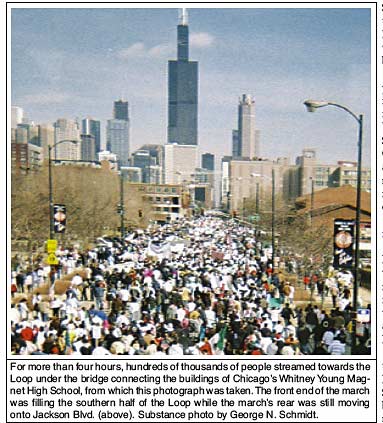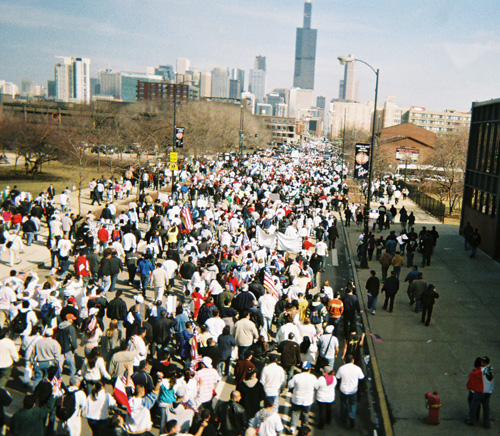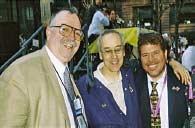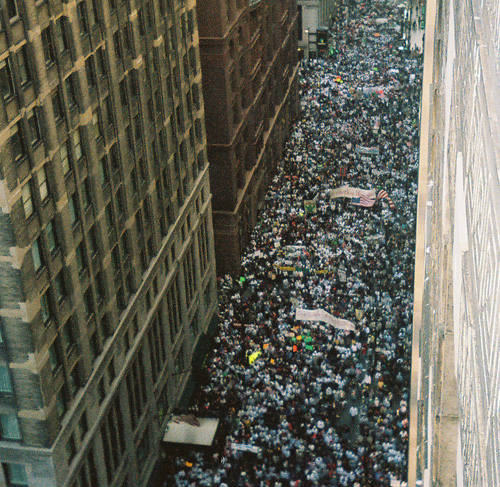MAY DAY HISTORY: Chicago public school student walkouts helped galvanize March 10, 2006, immigrant rights march in Chicago, a march paved the way for the largest May Day march in Chicago, the city that gave birth to the International Workers' Holiday
The archives of Substance contain part of the untold history of Chicago's public schools and the Chicago Teachers Union. One of the most important moments in that history came in 2006, when two marches for immigrant rights galvanized Chicago and helped give birth to the movement that elected Barack Obama President of the United States.  Photo and caption were originally printed in the April 2006 print edition of Substance.The first of those marches, on March 10, 2006, was largely ignored by America's corporate media (The New York Times didn't even report the event) — despite the fact that more than 200,000 people participated in Chicago. Even so-called "progressive" publications, such at The Nation, based their reports on what happened on what appeared in the corporate press, and because the news was largely blacked out in Chicago, Chicago's news didn't become part of the historical record.
Photo and caption were originally printed in the April 2006 print edition of Substance.The first of those marches, on March 10, 2006, was largely ignored by America's corporate media (The New York Times didn't even report the event) — despite the fact that more than 200,000 people participated in Chicago. Even so-called "progressive" publications, such at The Nation, based their reports on what happened on what appeared in the corporate press, and because the news was largely blacked out in Chicago, Chicago's news didn't become part of the historical record.
Substance reporters counted the more than 200,000 people who took part in the March 2006 march.
Below is part of that story, as reprinted here from www.substancenews.com, our old website, from the April 2006 edition of Substance.
 The May Day 2006 march and rally in Chicago would not have been built had it not been for the months of planning that had given rise to the March 10, 2006, immigrant rights march (above, as seen from the bridge of Whitney Young High School in Chicago) that was organized by immigrant rights groups, churches, and labor unions under the slogan "Immigrant Rights are Human Rights" and "Immigrant Rights are Workers' Rights." Substance photo by Dan Schmidt.
The May Day 2006 march and rally in Chicago would not have been built had it not been for the months of planning that had given rise to the March 10, 2006, immigrant rights march (above, as seen from the bridge of Whitney Young High School in Chicago) that was organized by immigrant rights groups, churches, and labor unions under the slogan "Immigrant Rights are Human Rights" and "Immigrant Rights are Workers' Rights." Substance photo by Dan Schmidt.
La Marcha’ empties schools, businesses by George N. Schmidt
It began in Chicago on March 10, 2006. The invisible suddenly became visible. By the time it had worked its way across the country in early April, more than two million Americans had taken to the streets from New York to Los Angeles. But it began in Chicago on March 10, 2006.
They left school by the tens of thousands, knowing they had to do something important but also knowing it would be fun. In response to the growing call from the communities that have always created and re-created the United States, children and teenagers whose families came from more than 30 countries left their homes on the morning of March 10, reported to public schools with names like Benito Juarez and Roberto Clemente, and then, within an hour after attendance was taken around 10:00 that morning, disappeared into Chicago’s streets.
In all, at least 30 Chicago elementary and high schools reported their students had left in large numbers that morning. Some went out from as far away as Senn High School (eight miles from the Loop) on the north and Gage Park High School (nine miles southwest of the rally site) on the south, but nobody got an accurate count.
By noon, the students reappeared in a sea of people numbering at least a quarter million that flowed from Ashland Ave. past Whitney Young High School and Skinner Elementary School into Chicago’s Loop. There the march and rally shut down the central business district of one of the largest and most powerful cities in the history of the world.
As tens of thousands of marchers moved slowly and peacefully into the Loop, Chicago’s police (who handled the event with as much restraint as the marchers showed in their ranks) funneled the march from Jackson Blvd. north to Adams St. The march then moved east again five blocks and into the Federal Plaza at Adams and Dearborn.
 Many of the organizers of the March 10, 2006, march in Chicago were working for the trade unions. Above, George Schmidt (Substance editor), Bill Silver, and Jose Arreola were all working at the time for SEIU Local 73. Substance photo by Dan Schmidt.Many of the organizers of the March 10, 2006, march in Chicago were working for the trade unions. Just beore the march had finally ‘ended’ after 4:00 p.m. Substance took photographs from an upper floor of Chicago Public Schools headquarters at the northeast corner of Adams and Clark streets. Several photographs taken looking west from Clark to LaSalle (the heart of Chicago’s financial district, which was closed by the event), enabled Substance to estimate the crowd's size. Substance editor George Schmidt and son Dan Schmidt did a rough calculation based on several actual counts of the number of people filling each linear block and estimated that the total number of marchers was between 180,000 and 250,000.
Many of the organizers of the March 10, 2006, march in Chicago were working for the trade unions. Above, George Schmidt (Substance editor), Bill Silver, and Jose Arreola were all working at the time for SEIU Local 73. Substance photo by Dan Schmidt.Many of the organizers of the March 10, 2006, march in Chicago were working for the trade unions. Just beore the march had finally ‘ended’ after 4:00 p.m. Substance took photographs from an upper floor of Chicago Public Schools headquarters at the northeast corner of Adams and Clark streets. Several photographs taken looking west from Clark to LaSalle (the heart of Chicago’s financial district, which was closed by the event), enabled Substance to estimate the crowd's size. Substance editor George Schmidt and son Dan Schmidt did a rough calculation based on several actual counts of the number of people filling each linear block and estimated that the total number of marchers was between 180,000 and 250,000.
Additional thousands joined the rally in the Loop itself. Police estimates said “in excess of 100,000,” but the careful estimate by Substance indicated that the march had drawn more than double that number.
 The photo above, showing one block of the crowd that stretched for more than 12 blocks to the west and filled the streets surrounding Chicago's federal buildings, was taken from the window of the conference room of the Chicago Board of Education's headquarters office of budget during the March 10, 2006 march. Officials of the CPS office of management and budget, many of whom were from families of immigrants, assisted Substance in getting the above photograph during the march so that the size of the march would be seen despite later attempts to downplay it. Substance photo by George N. Schmidt.“My father is not a criminal,” read one sign among thousands.
The photo above, showing one block of the crowd that stretched for more than 12 blocks to the west and filled the streets surrounding Chicago's federal buildings, was taken from the window of the conference room of the Chicago Board of Education's headquarters office of budget during the March 10, 2006 march. Officials of the CPS office of management and budget, many of whom were from families of immigrants, assisted Substance in getting the above photograph during the march so that the size of the march would be seen despite later attempts to downplay it. Substance photo by George N. Schmidt.“My father is not a criminal,” read one sign among thousands.
As the month wore on, similar rallies took place in cities as diverse as Los Angeles (where a half million people filled downtown and finally topped Chicago’s total) to tiny places like Alvin, Texas, where a couple of hundred left school in late March.
More than two million had taken to the streets by month’s end.
Organization for the rally was done by hundreds of people, but several were given major credit for the event. Among those was SEIU Local 73 executive board member Jose Arreola (above, right) with fellow SEIU people. The most important organizing for both the March and May Day 2006 events was done by SEIU vice president Cynthia Rodriguez. Substance Editor George Schmidt, SEIU Rep Bill Silver, and Jose Artemio Arreola celebrated at federal plaza at the end of the March 10 march.


By: Theresa D. Daniels
George's proud legacy
I know George had to be awfully proud of these photographs. He is so missed.